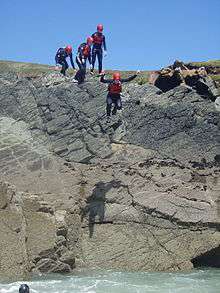Coasteering

Coasteering is a physical activity that encompasses movement along the intertidal zone of a rocky coastline on foot or by swimming, without the aid of boats, surf boards or other craft. It is difficult to define the precise boundaries between, for example, rockpooling and ocean swimming. Coasteering may include all or some of the following:
- Swimming or Adventure Swimming: in calm water; rough or white water; and/ or tidal currents. Dressing for swimming in the sea (wetsuits, buoyancy aids etc.) is an integral part of Coasteering; even on routes where it is possible to stay dry. A route, or activity, where the group start out with the intention of staying dry - whether through route choice or the use of ropes and harnesses - is not coasteering.
- Climbing, scrambling, canyoning, sea level traversing: the very nature of the coastline that is needed for coasteering demands aspects of these activities. Ropes, as security on rock, are not used. Any climbing activity usually takes place above deep water, with safety spotters used where appropriate. There is a similarity to the sport of deep-water soloing, but this would normally be carried out by experienced individuals not wearing equipment suitable for coasteering. Coasteering is never a dry, climbing activity.
- Jumping and Diving: are often seen as an appealing and exciting part of coasteering. These activities actually make up minimal content of a coasteering session.
A defining factor of coasteering is the opportunity provided by the marine geology for moving in the “impact zone” where water, waves, rocks, gullies, caves etc., come together to provide a very high energy environment.
History
Although all aspects of coasteering have been informally practised by people for a very long time, if only as a means of access to a cut-off cove beyond a headland, the term appears first to have been used in 1973. In a prescient vision in the book Sea Cliff Climbing, John Cleare and Robin Collomb said "A few enthusiasts believe that coasteering will become popular and has a big future".
In the 1990s, it emerged as a commercially guided recreational activity initially along the cliff coastline of Pembrokeshire in Wales. By 1997 write-ups started appearing in the travel/recreational pages of the newspapers showing that several commercial companies were offering such activity.
In 1999, one guide company licensed a trade mark incorporating the word "Coasteering" in a distinctive script. However, the word was by then in general use to describe the activity.
The activity then spread to all regions of the UK where there are suitable rocky coasts, including Cornwall, Pembrokeshire, Anglesey and the Highlands and Isles of Scotland.
Dorset was one of the last counties with a suitable coastline to offer coasteering, with commercial providers starting to offer the activity as late as 2009; However Dorset is now arguably the busiest coasteering destination in the UK with upwards of 10,000 paying clients every year.
The advisory organisation for coasteering is the National Coasteering Charter (NCC).
In the UK the activity is recognized by the Adventure Activities Licensing Authority which is a department of the Health and Safety Executive.
Guided adventure experience
The rocky cliff coasts of western Britain provide the world's principal location for organised guided coasteering, where it is available from over 100 activity centres.[1] Usually half day or one day trips are offered at a variety of levels catering for beginners, intermediates and advanced. Some trips are especially slanted towards study of the coastal ecology.
Some centres cater for parties of school children.
Adventure races
Coasteering may be included as one of the disciplines for a stage of an adventure race. This is especially common in New Zealand, but is also to be found in Australia, Canada, and the USA.
Safety
In the UK, the HSE has an information sheet of good practice for the Adventure Activities Industry .
Basic safety equipment
Safety equipment reflects the environment in which the sport is performed and often includes:
- Wetsuit (for cooler waters outside the tropics)
- Protective clothing and gloves to prevent abrasions - may be provided by the wet suit
- Shoes to provide grip on rocks
- Buoyancy aid
- Helmet
Hazards
Because of the diverse practices involved in the sport there are a number of hazards.[2]
- Impact with rocks
- Drowning
- Hypothermia
See also
References
| Wikimedia Commons has media related to Coasteering. |